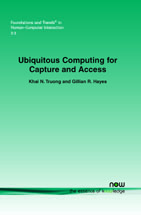Ubiquitous Computing for Capture and Access
By Khai N. Truong, University of Toronto, Canada, khai@cs.toronto.edu | Gillian R. Hayes, University of California, USA, gillianrh@ics.uci.edu
Abstract
People may want to recall a multitude of experiences and information from everyday life. Human memory, however, has its limitations and can be insufficient for capturing and allowing access to salient information and important details over time. A variety of tools — primitive, analog, or digital — can complement natural memories through recording. Throughout history, in fact, record keeping and documentation have become increasingly important. In recent years, ubiquitous computing researchers have also designed and constructed mechanisms to support people in gathering, archiving, and retrieving these artifacts, a broad class of applications known as capture and access.
In this paper, we overview the history of documentation and recording leading broadly from primitive tools into the current age of ubiquitous computing and automatic or semi-automatic recording technologies. We present historical visions motivating much of the early computing research in this area. We then outline the key problems that have been explored in the last three decades. Additionally, we chart future research directions and potential new focus areas in this space. This paper is based on a comprehensive analysis of the literature and both our experiences and those of many of our colleagues.
Ubiquitous Computing for Capture and Access
The history of capturing and accessing records of human experience is long and filled with varied motivations, technological innovations, and social and political phenomena. As recording technologies become more powerful and ubiquitous, the research designs of the past have become everyday realities even while new research areas have been opened. Ubiquitous Computing for Capture and Access overviews the history of documentation and recording, leading broadly from primitive tools into the current age of ubiquitous computing and automatic or semi-automatic recording technologies. It presents historical visions motivating much of the early computing research in this area and goes on to outline the key problems that have been explored in the last three decades. It concludes by charting future research directions and potential new focus areas in this space. Ubiquitous Computing for Capture and Access serves as both a review of what has already been accomplished in this area and a jumping off point for the capture and access research of the future
